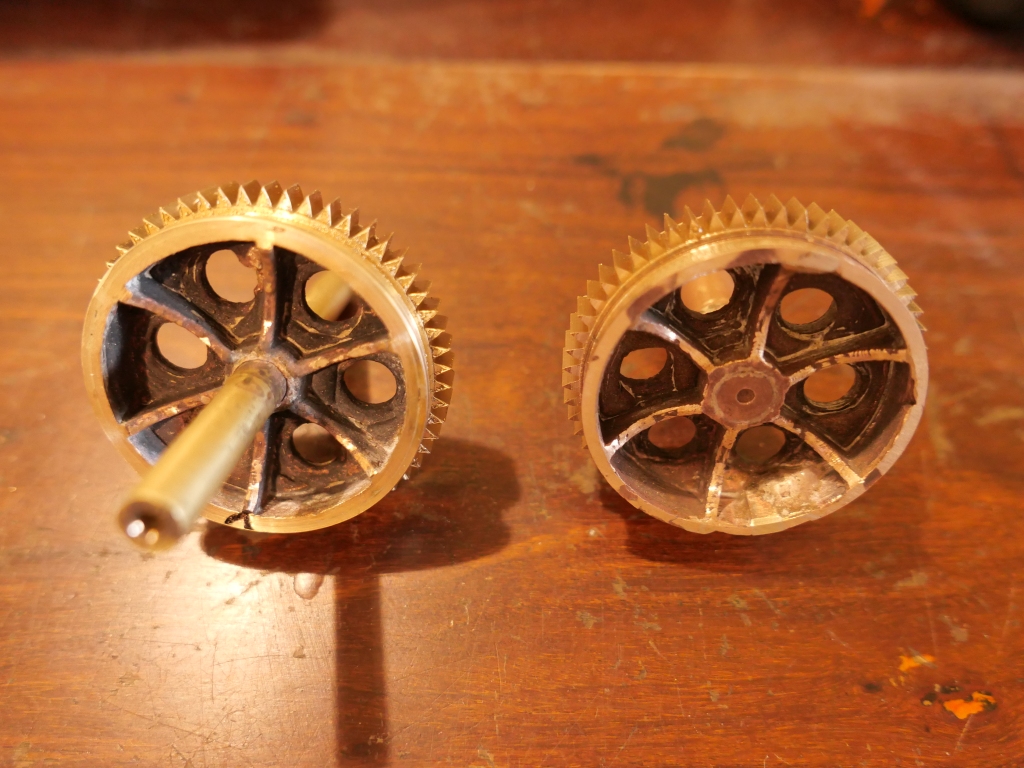Casting Bubbles
by John
When bubbles occur inside a casting, the cause is probably in the design of the pouring system, or the way the melt was poured. If you watched the video a few posts ago by Prof. John Campbell you would think, as I did, that our pouring funnels and sprues should be more complex and more carefully designed. Difficult at an amateur level. I have made some changes in this direction, using a side reservoir to tip the melt into, and trying to avoid the gurgling and glugging.
With the sort of castings which I have been making for the Armstrong cannon, I am not so concerned about internal voids. The scaled down model always has an advantage in strength of the part, compared with the full size part, within limits.
But, bubbles which stick to the exterior of lost PLA/wax models are replaced by solid bronze, or whatever metal is used, and these metal bubbles can be tricky and difficult to remove.
I decided to remake the big gears, which were the subject of the last few posts, and the cause of a lot of bad language. I decided that the gear teeth were too skinny and pointy, and redesigned the part using larger module teeth. To compensate for PLA shrinkage and metal shrinkage I printed the PLA parts with a 2mm machining allowance.

I printed the PLA blanks, leaving the gears and brake drums as a blank lump which I will turn to shape after casting. But the internal decorative holes and ribs will be cast. And they are the site of many bubbles in previous castings.
So, to avoid the bubbles, I am trying something different in the current casting session. I am trying a method which was suggested by a GSMEE member, and that is to PAINT the first layer of investment material thinly on the tree components, making sure that no bubbles stick to the parts, then to pour the rest of the investment filling the cylinder. There might be some bubbles in the main volume of the pour, but they should not be sticking to the parts. That is the theory anyway. I am waiting for a bigger vacuum pump to arrive by post, which should be more effective at sucking out the bubbles, but meanwhile, I will try this…

Today, I heated 2 cylinders/moulds in the investment oven, and melted some bronze.
For the pour I tried the negative pressure apparatus.
I did not notice any change in the level of the molten bronze in the reservoirs when I applied the negative pressure, so I doubt that it added much to the process.
The results were like the curate’s egg… some good, some bad.





I am waiting for a more powerful vacuum pump to arrive by post. The 1/4hp one that I am currently using is too slow, when time is critical. I have a 1hp pump on order. No more casting until it arrives.

John;
Saw an idea on You Tube, or Instructables, yesterday, where a person doing casting poured his investment powder into the cylinder, then held an orbital sander against the side of the cylinder, and worked it around for a short while.
Might have been done for effect, but you could see bubbles rising in the wet mix.
He also did the same thing on the sides of the cylinder when he did the metal pour. Bubbles weren’t as visible the second time. May not have been able to rise in the heavier molten metal.
Ian Munro
LikeLike
I have tried that. Vacuuming is more effective, and doesn’t fill the room with old sanding dust.
LikeLike
Here we get to know about the casting bubbles. It helps us to decide that which one is best among its types. I enjoyed reading this article and would suggest others it as well. Thank you for this article! This is really very informative for us. I have also found this resource https://peerlessengineering.com/ useful and its related to what you are mentioning.
LikeLike